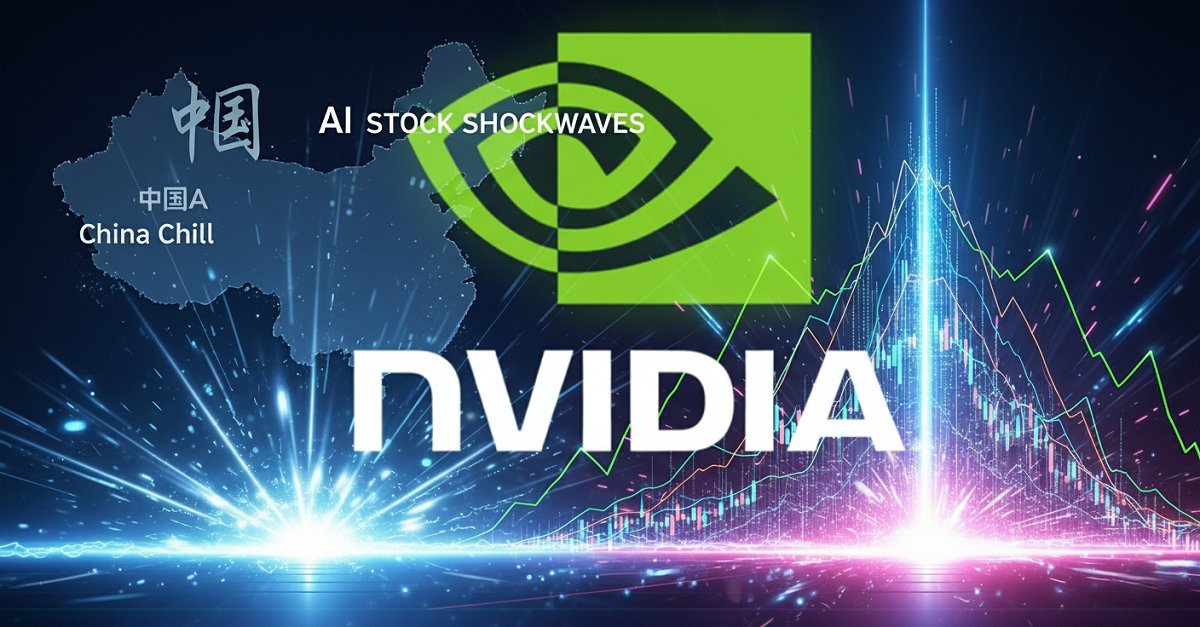Nvidia Q3 2025 earnings delivered impressive topline numbers—but markets responded with caution. The chip giant reported a staggering 56% year-over-year revenue growth to $46.7 billion, buoyed by demand for its Blackwell-based AI datacenter platforms. Yet, investor concerns—namely unresolved China H20 chip sales and lightly underwhelming data center growth—dampened enthusiasm. The result? A notable pullback in Nvidia’s stock and reverberations across the broader AI sector.
Q3 Highlights — Magnitude Meets Mismatch
- Revenue & Profit Surge
Nvidia posted $46.7B in Q2 fiscal 2026 revenue (effectively Q3 calendar), marking a +56% year-over-year increase, with datacenter revenue at $41.1B, also up 56%. Gross margin held strong at ~72–73% despite high volume.
Blackwell AI chip revenue grew 17% sequentially, fueling confidence in Nvidia’s product roadmap. - China H20 Sales Stall
Nvidia reported no H20 chip sales to China this quarter, citing political and regulatory uncertainty. Though the Q3 forecast excludes Chinese H20 chip revenue, CFO estimated a potential $2–$5B upside if restrictions ease. This gap introduced investor unease. - Q3 Forecast & Market Reaction
Forecasted revenue of $54B (±2%) beat expectations, but markets fixated on deceleration in data center growth—marking the first single-digit sequential rise. Nvidia shares slid ~3% in after-hours trading.
What Analysts Are Saying—Cautious Optimism Amid Concerns
- Short-term disappointment, long-term faith
Analysts view the earnings beat as solid, yet not sensational. The lack of H20 sales in China and modest data center growth reminded the market that explosive annual growth will eventually moderate. - AI infrastructure remains intact
Most believe the AI cycle is still in early innings. Strong hyperscaler demand for Blackwell and AI tooling provides durable tailwinds. Comments on continued capex reinforce the narrative of sustained growth. - China access is the wildcard
The unresolved H20 sales situation—and changing political dynamics—inject volatility. Analysts estimate notable upside if China trade restrictions are resolved, but stress risk remains.
Impact on Nvidia & AI Stocks — Broader Ripple Effects
Nvidia’s Stock & Market Sentiment
- The stock’s 3–5% drop post-earnings reflects investor sensitivity to forward momentum despite strong fundamentals.
- The premium valuation (over 50% annual growth at a $50B revenue run-rate) is under pressure when growth slows.
AI Sector Ripples
- Nvidia’s results act as a bellwether for AI semiconductor demand; its caution spreads to peers, ETFs, and AI-adjacent stocks.
- Companies such as AMD, TSMC, and hyperscale AI infrastructure suppliers could face short-term pressure from guidance risks.
China Tech Stocks & National Competitors
- Chinese AI chipmakers rallied as Nvidia’s standoff with Beijing created perceived opportunities for domestic players.
- Markets like the STAR 50 Index saw gains, while broader tech indices adjusted for geopolitical risk sensitivity.
At a Glance — Quick Wrap
| Category | Insight Summary |
|---|---|
| Performance | 56% YoY revenue spike; strong margins and Blackwell ramp at scale |
| China Risk | No H20 chips sold in Q2; $2–$5B potential upside if access resumes |
| Guidance | Q3 forecast $54B beats expectations, yet cautious tone prevails |
| Stock Impact | Shares dipped ~3% after-hours despite robust numbers |
| AI Sector | Reinforces long-term AI run; short-term sentiment shifts visible |
| Investor Sentiment | Bullish on infrastructure, cautious on China and future growth pace |
Takeaway — What Investors Should Do Now
- Watch China developments closely. Any updates on H20 export rules or regulatory relief could be a major catalyst.
- Monitor Blackwell adoption. Tracking cloud provider commitments to Blackwell platforms will signal continued AI capex strength.
- Gauge sector sentiment through mega-cap tech. Nvidia’s caution may signal broader AI investor wariness—an entry point or a warning sign.
- Stay tactical and diversified. Short-term volatility is likely, but long-term AI infrastructure demand remains intact.
Conclusion: Strong Earnings, Lingering Uncertainties
Nvidia’s Q3 2025 earnings showcased astounding growth and execution—but also the limits of investor expectation. Strong topline and infrastructure demand collided with geopolitical tension and a mild guidance reset. For AI investors, it’s a moment to recalibrate, not retreat.
FAQs: Nvidia Q3 Earnings 2025 and AI Stock Market Impact
Nvidia’s Q3 2025 earnings report showed strong revenue growth driven by its AI and data center business. The company’s gaming division also maintained stable performance, while demand for AI chips surged across global markets.
After the Q3 earnings announcement, Nvidia’s stock experienced significant volatility but showed an overall upward trend due to strong AI chip demand and positive future guidance.
Nvidia plays a leading role in AI infrastructure. Its Q3 2025 performance signals future growth trends for AI-related stocks, including companies in semiconductors, cloud computing, and automation.
Sectors such as artificial intelligence, semiconductor manufacturing, autonomous vehicles, and cloud computing benefit directly from Nvidia’s performance, as the company sets the pace for AI innovation.
Nvidia stock remains one of the strongest performers in the technology sector. With AI demand accelerating globally, analysts expect continued long-term growth, though investors should consider market volatility.
Nvidia outperformed its major competitors in Q3 2025, especially in AI and data center revenue. While AMD and Intel remain strong players, Nvidia holds a dominant market share in AI GPUs.
Nvidia’s results often influence tech-heavy indexes like the Nasdaq. Strong Q3 earnings may boost investor confidence in AI-related stocks and drive sector-wide momentum.
Analysts predict that Nvidia stock could continue its upward trajectory into 2026, with sustained demand for AI, gaming, and autonomous technology chips, though macroeconomic conditions will play a key role.









